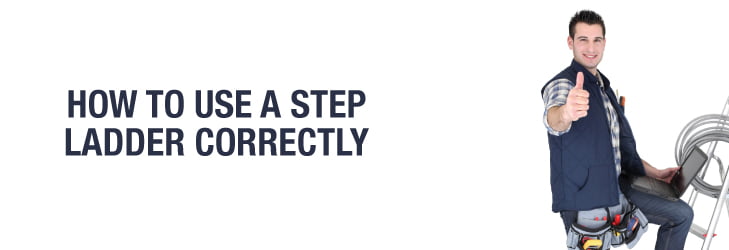How to use a step ladder correctly
11/09/2014

Last week we were looking at how to use a ladder correctly and this week we’re focusing specifically on how to use a step ladder correctly. You may think the same process applies whatever type of ladder you’re working with, but unfortunately that’s not the case!
Choosing the right step ladder
Whether you’re browsing step stools or larger step ladders, it’s fundamental you choose the right one for the job. As a rough guide, 4-8 tread folding step ladders are most commonly suited to jobs around the house, but the number of treads must match the requirement of the job. Some are too short for high work, and some are too tall for lower work. Your must be able to do your work comfortably without over-reaching up, down or sideways.
All of our step ladders at Browns Ladders meet British and European standards – make sure that your stepladder does too. You can cross check you ladder with the British standards here.
Another important thing to consider when choosing your stepladder is its safe working load. New stepladders are generally marked according to their safe working load and include a classification of EITHER the duty rating OR maximum static vertical load.
Duty Rating covers the weight of the user plus the weight of the tools and materials that are allowed when moving up and down on the product.
Maximum vertical safe working load is a useful and accurate guide to the total weight that each piece of equipment can take.
British Standard Stepladders to BS2037 (Aluminium) or BS1129 (Timber)
- Class 1 (Industrial) Duty rating 130kg OR Maximum Vertical Static Load 175kg
- Class 3 (Domestic) Duty Rating 95kg OR Maximum Vertical Static Load 125kg
European Standard stepladders to BSEN131 (All Types)
- (Previous Class 2) Duty rating 115kg OR Maximum Vertical Static Load 150kg
Pre-use checks
As with any ladder, it’s essential that you carry out pre-use checks to ensure your safety. Pre-use checks need to be carried out whenever your situation changes – for example, at the beginning of each day, and after moving the stepladder.
Pre-use check guide:
- Check the stiles are not bent or damaged
- Check the feet are in good condition and in contact with the ground
- Check the rungs aren’t bent, worn, missing or loose
- Check the locking mechanisms and their fixings – they mustn’t be damaged, bent or worn.
All four of these checks need to be satisfactory. If just one of these checks fails, the stepladder isn’t safe to work with.
Using your step ladder correctly
There’s a lot to consider before even stepping onto your stepladder. Once you begin using it though there’s still a number of things you can do to ensure your safety:
- Check all four stepladder feet are in contact with the ground and the steps are level
- Only carry light materials and tools on the stepladder
- Don’t overreach and don’t stand and work from the top three steps unless there is a suitable handhold. Choosing the right height ladder is paramount!
- Ensure any locking devices are engaged
- Try to position the stepladder to face the work activity and not side on. However, there are occasions when a risk assessment may show it is safer to work side on, eg. in retail stock room when you can’t engage the stepladder locks to work face on because of space restraints in narrow aisles. Where these side-on loadings cannot be avoided, you should prevent the steps from tipping over eg by tying the steps. Otherwise, use a more suitable type of access equipment
- Maintain three points of contact at the working position. This means two feet and one hand, or when both hands need to be free for a brief period, two feet and the body (knees and chest) supported by the stepladder
For more guidance on working safely at a height, you may like to book onto one of our safety courses or read our last blog on how to use a ladder correctly.